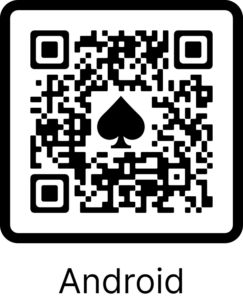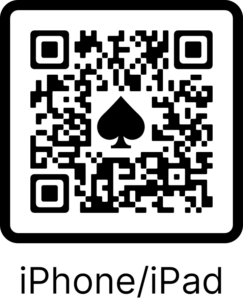It's a 2 vs 2 Game
4 players, 2 vs 2. You sit across the table from your partner. They're the most important person in your life while you're playing bridge.
You and your partner are either called North and South, or East and West. You don't actually sit in those directions -- "North" and "South" etc are just monikers.
Deal out the whole deck face-down (no jokers)
52 cards. 13 cards each.
Don't show your cards to anyone else, including your partner.
Aces are high, then Kings, then Queens, Jacks, 10's, 9's, etc.
2's are the lowest cards.
Bidding first, then Play
First, the players bid ("the auction"), and then they play 13 tricks ("the play").
We'll talk later about the bidding -- it only makes sense after we learn what the PLAY is.
♠ The Play ♥
Just Win Tricks
The goal in bridge is to win tricks. Your team should win as many tricks as you can.
What's a trick? It's where you go around the table clockwise, each player choosing a card from their hand and playing it face-up when it's their turn. The highest card played wins the trick.
You must follow suit in each trick, which means you have to play a card in the suit that started the trick.
The Trick Winner Leads
Whoever wins the trick plays first on the next trick.
When starting a trick, you can lead ANY card of your choice from your hand. Then, everyone else has to follow suit.
Discard if you Can't Follow Suit
Somebody started a trick by leading a Heart, but you don't have any Hearts. What do you do when it's your turn to play on the trick?
You discard, which means you play, face-up, ANY other card of your choice from your hand. You won't win the trick when you discard (but your partner might, if they can follow suit and play a higher card than both the opponents).
If your Partner Wins, it Counts for Your Team
You and your partner have a shared score. Whether you win the trick or your partner does -- it counts for your team.
If your partner plays an Ace on a trick, you will often want to play your lowest card when the trick comes around to you. This is because your partner is already winning the trick for your team, so you'll usually dump your bad cards on tricks where Partner is winning.
There's also a Trump Suit
In any deal of bridge, one of the four suits can be named the trump suit. This is the power suit, and it's decided in the bidding (more on that later). All cards in the trump suit beat ALL other cards. If Clubs is trump, for example, even the 2 of Clubs will beat the Ace of every other suit.
There's only one problem: You still have to follow suit! So if an opponent leads the Ace of Hearts, and Clubs are the trump suit, you can't just play a Club and win -- if you have a Heart in your hand, you must play a Heart if a Heart was led to start the trick.
It's Nice to Have a Lot of Trump Cards
Say you have 9 Diamond cards in your hand. That's a lot of Diamonds -- there's only 13 in the whole deck! You definitely want Diamonds to be the trump suit. So how do you do that?
You bid it. (see below)
♦ The Bidding ♣
The Bidding Decides the Trump Suit
After dealing out 13 cards to each player at the start of the deal, the four players bid. The point of the bidding is to decide two things:
1. What the trump suit will be on this deal, or if there will be no trump suit at all ("Notrump").
2. How many tricks (out of 13) each team has to win in order for their team to win points. Only one team can win points on any deal.
A Bid is a Number and a Suit
A bid looks like this: "3 Hearts" or "5 Clubs" or "1 Notrump." Each bid is a number between 1 and 7, and a suit (or Notrump).
The suit in your bid is what you want the trump suit to be, which is usually your longest suit (or Notrump, if you have good cards in all the suits.)
The number in your bid is the number of tricks that you think your team can win on this deal, plus 6. You always add 6 to the number in your bid, and that's the number of tricks your team has to win.
Example Bid: "3 Hearts" =
"My team can win at least 9 tricks (3+6) if Hearts is the trump suit."
Only the Highest Bid Counts
The bidding is an auction. Starting with the dealer, the players go around clockwise bidding higher and higher until nobody dares bid any higher. This means you will often get to make more than one bid on a deal.
If you don't want to bid when it's your turn, you can "Pass."
The bidding ends when any bid is followed by all the other players Passing. The team that made the highest bid ("the contract") is on the offense, and the other team will now try to prevent them from winning enough tricks to make their contract. All the lower bids from the auction are thrown away.
The Bidding is a Language You Learn
You can't see anyone's cards but your own, not even your partner's! You use your bids to communicate the strength and suit distribution of your hand to your partner so that, together, you can figure out the best contract to bid for your team.
The "language" of bidding has evolved over the years. For example, if you're the dealer and you open the bidding with "1 Heart," that ostensibly says "I think we can make at least 7 tricks if Hearts is the trump suit." But in modern American bidding, it also means something specific: that you have at least 5 Heart cards in your hand. This level of detail helps your partner make an informed decision about what to bid next.
It's Not as Hard As It Sounds
Learning the specific, conventional "meanings" of bids is part of why people think bridge is hard to learn.
But don't worry -- the bid meanings all make sense, and they're fun to learn over time. You can learn most of them quickly.
You'll gradually improve your bidding vocabulary until you and your partner are communicating so well that you can start to see your partner's cards in your head.
One Player Will be the "Dummy"
Weird Rule Alert! Say you and your partner win the bidding because one of you made the highest bid, and everyone else Passed. What now?
It's time to play 13 tricks. Your team bid the contract, so you're on the offense. The opponents will start the first trick by leading a card. Then, something interesting happens: Either you or your partner will put your whole hand down face-up on the table for everyone to see. The player that does that is called "the Dummy."
At this point, the Dummy makes no more decisions. Whenever it's the Dummy's turn to play a card, their partner tells them what to play. In order words, the Dummy's partner controls both their own hand and the Dummy's hand for the rest of the deal!
Playing Full Bridge
Putting It Together
You're ready to play! Deal out the whole deck -- 13 cards each, face-down -- and have the dealer start the bidding. 1 Club is the lowest possible bid (besides Pass). The next lowest is 1 Diamond, then 1 Heart, 1 Spade, and then 1 Notrump. Then 2 Clubs, 2 Diamonds, 2 Hearts, etc. The highest possible bid is 7 Notrump, which means your team has to win all 13 tricks ... with no trump suit! You can start the bidding with any bid -- it doesn't have to be a low bid (you could jump straight to 7 Notrump as your first bid if you wanted, but that's extremely rare).
Say your team bids the highest, and your contract is 4 Spades. Who's the dummy, you or your partner? The dummy is always the partner of the player on the offense who bid the trump suit first on that deal. So, if you bid Spades first (say, by opening with a 1 Spade bid, and then Partner raised to 4 Spades), your partner would be the Dummy, and the opponent sitting to Dummy's right always leads the first card of the first trick. (The partner of the Dummy is called the Declarer.)
Make Your Contract, or Defeat Theirs
Your goal is always the same: Win as many tricks as possible. Your hope, if you are on the offense, is to win enough tricks to make the contract that your team bid, but there's no bonus for making the exact number of tricks promised in your contract. Win as many tricks as you can! (You'll get extra points for each "overtrick.")
If you're on the defense, same thing: win tricks, hoping to defeat the opponents by winning so many tricks that the opponents fail to make their contract. If you defeat them, you get penalty points, and the offense gets no points at all.
Worry About the Point-Scoring Later
When you make or defeat a contract, your team gets points. How many points? Learning how the point-scoring works in bridge is probably the least fun part, because it feels arbitrary at first. But don't worry -- once you understand the scoring system, bridge gets even more fun.
The fastest, most fun way to learn all of this is by playing, which you can do (entirely for free with no pop-up ads) in the Tricky Bridge app! Tap or scan below to download it.
Watch Some Bridge
It helps a lot to watch bridge being played. Check out Twitch streams of bridge players and hear their commentary -- you'll quickly begin to get a sense of how bridge players think, which will help you start to enjoy the strategy and complexities of the game. We recommend this streamer.
Learn Faster by Playing Face-to-Face if you have the chance
Learn bridge basics in the Tricky Bridge app, then find a local bridge club to play with other newcomers to the game. Bridge is very fun when played face-to-face.
Do you have relatives who play bridge? A good gift for a bridge-loving grandparent is to tell them that you learned how to play bridge, and then play as their partner! (Warning: They will try to teach you complicated bidding conventions.)
Competition
When you're ready, most countries have national bridge organizations that organize tournaments for all levels. Here's the one for America and Canada, which awards coveted "Masterpoints" for doing well in tournaments at any level. Earn enough Masterpoints, and you'll become a Life Master.
Look for the "newcomer" tournament events. You'll be playing only against other new players, so it's a low-stress introduction to "duplicate" bridge competition (duplicate is where all the tables in the event play the exact same deals, and then each team's score for that deal is compared on a leaderboard).
That's how to play bridge, in a nutshell. Sound complicated? Well, it's the only game left in the world where the best AI cannot defeat the best human players, so, yes, it's challenging. But bridge is fun at all skill levels. Start playing, discover more about how your mind works, and join the hundreds of millions of people who love it!
Download Tricky Bridge:



